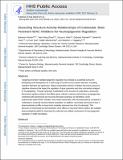| dc.contributor.author | Ghosh, Balaram | |
| dc.contributor.author | Zhao, Wen-Ning | |
| dc.contributor.author | Reis, Surya A. | |
| dc.contributor.author | Patnaik, Debasis | |
| dc.contributor.author | Fass, Daniel M. | |
| dc.contributor.author | Tsai, Li-Huei | |
| dc.contributor.author | Mazitschek, Ralph | |
| dc.contributor.author | Haggarty, Stephen J. | |
| dc.date.accessioned | 2018-03-19T17:45:46Z | |
| dc.date.available | 2018-03-19T17:45:46Z | |
| dc.date.issued | 2016-01 | |
| dc.date.submitted | 2016-01 | |
| dc.identifier.issn | 0960-894X | |
| dc.identifier.uri | http://hdl.handle.net/1721.1/114212 | |
| dc.description.abstract | Targeting chromatin-mediated epigenetic regulation has emerged as a potential avenue for developing novel therapeutics for a wide range of central nervous system disorders, including cognitive disorders and depression. Histone deacetylase (HDAC) inhibitors have been pursued as cognitive enhancers that impact the regulation of gene expression and other mechanisms integral to neuroplasticity. Through systematic modification of the structure of crebinostat, a previously discovered cognitive enhancer that affects genes critical to memory and enhances synaptogenesis, combined with biochemical and neuronal cell-based screening, we identified a novel hydroxamate-based HDAC inhibitor, here named neurinostat, with increased potency compared to crebinostat in inducing neuronal histone acetylation. In addition, neurinostat was found to have a pharmacokinetic profile in mouse brain modestly improved over that of crebinostat. This discovery of neurinostat and demonstration of its effects on neuronal HDACs adds to the available pharmacological toolkit for dissecting the molecular and cellular mechanisms of neuroepigenetic regulation in health and disease. Keywords: Cognitive enhancer; Nootropic;
Histone deacetylases; Epigenetic; Chromatin; Acetylation; CREB; Neuroepigenetic | en_US |
| dc.publisher | Elsevier BV | en_US |
| dc.relation.isversionof | http://dx.doi.org/10.1016/J.BMCL.2016.01.022 | en_US |
| dc.rights | Creative Commons Attribution-NonCommercial-NoDerivs License | en_US |
| dc.rights.uri | http://creativecommons.org/licenses/by-nc-nd/4.0/ | en_US |
| dc.source | PMC | en_US |
| dc.title | Dissecting structure–activity-relationships of crebinostat: Brain penetrant HDAC inhibitors for neuroepigenetic regulation | en_US |
| dc.type | Article | en_US |
| dc.identifier.citation | Ghosh, Balaram et al. “Dissecting Structure–activity-Relationships of Crebinostat: Brain Penetrant HDAC Inhibitors for Neuroepigenetic Regulation.” Bioorganic & Medicinal Chemistry Letters 26, 4 (February 2016): 1265–1271 © 2016 Elsevier Ltd | en_US |
| dc.contributor.department | Picower Institute for Learning and Memory | en_US |
| dc.contributor.mitauthor | Tsai, Li-Huei | |
| dc.relation.journal | Bioorganic & Medicinal Chemistry Letters | en_US |
| dc.eprint.version | Author's final manuscript | en_US |
| dc.type.uri | http://purl.org/eprint/type/JournalArticle | en_US |
| eprint.status | http://purl.org/eprint/status/PeerReviewed | en_US |
| dc.date.updated | 2018-02-21T14:15:07Z | |
| dspace.orderedauthors | Ghosh, Balaram; Zhao, Wen-Ning; Reis, Surya A.; Patnaik, Debasis; Fass, Daniel M.; Tsai, Li-Huei; Mazitschek, Ralph; Haggarty, Stephen J. | en_US |
| dspace.embargo.terms | N | en_US |
| dc.identifier.orcid | https://orcid.org/0000-0003-1262-0592 | |
| mit.license | PUBLISHER_CC | en_US |
